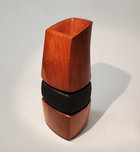I'm planning on trying my hand at ebonizing the outside of a bowl using India ink. I saw in a video that I should use a thin coat of shellac as a sealer to stop the ink from bleeding through the end grain. I generally use Tried and True (Linseed Oil) as a finish, and was curious if the sealing coat of shellac would inhibit the Tried and True from penetrating the wood as it normally does.
Any tips or advice would be appreciated
Any tips or advice would be appreciated

